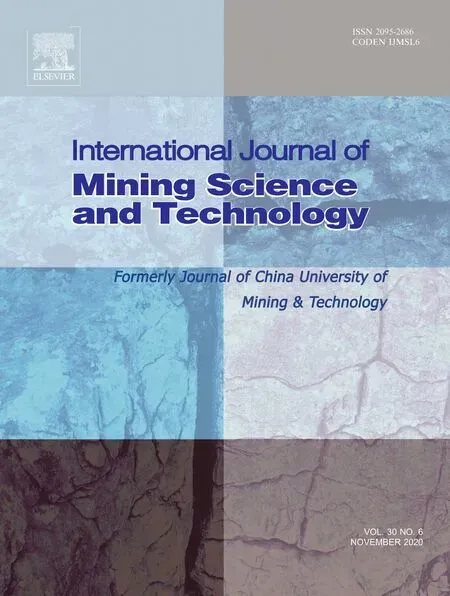Key technologies and engineering practices for soft-rock protective seam mining
2020-12-20XingChengGungmingZhoYingmingLiXingruiMengQingyiTu
Xing Cheng ,Gungming Zho,Yingming Li ,Xingrui Meng ,Qingyi Tu
a State Key Laboratory of Mining Response and Disaster Prevention and Control in Deep Coal Mines,Anhui University of Science and Technology,Huainan 232001,China
b Geological Resources and Geological Engineering Post-Doctoral Flow Station,Anhui University of Science and Technology,Huainan 232001,China
c Post-Doctoral Research Station,Huaibei Mining Corporation Limited,Huaibei 235006,China
ABSTRACT Severe gas disasters in deep mining areas are increasing,and traditional protective coal seam mining is facing significant challenges.This paper proposes an innovative technology using soft rock as the protective seam in the absence of an appropriate coal seam.Based on the geological engineering conditions of the new horizontal first mining area of Luling Coal Mine in Huaibei,China,the impacts of different mining parameters of the soft-rock protective seam on the pressure-relief effect of the protected coal seam were analyzed through numerical simulation.The unit stress of the protected coal seam,which was less than half of the primary rock stress,was used as the mining stress pressure-relief index.The optimized interlayer space was found to be 59 m for the first soft-rock working face,with a 2 m mining thickness and 105 m face length.The physicochemical characteristics of the orebody were analyzed,and a device selection framework for the soft-rock protective seam was developed.Optimal equipment for the working face was selected,including the fully-mechanized hydraulic support and coal cutter.A production technology that combined fully-mechanized and blasting-assisted soft-rock mining was developed.Engineering practices demonstrated that normal circulation operation can be achieved on the working face of the soft-rock protective seam,with an average advancement rate of 1.64 m/d.The maximum residual gas pressure and content,which were measured at the cut hole position of the protected coal seams (Nos.8 and 9),decreased to 0.35 MPa and 4.87 m3/t,respectively.The results suggested that soft-rock protective seam mining can produce a significant gas-control effect.
Keywords:Gas outburst hazard Soft-rock protective seam Pressure-relief Three-machine optimization Blasting-assisted mining Gas extraction
1.Introduction
In China,underground mining is the predominant form of coal mining.However,most coal mines are gassy mines,and coal-bed gas in mines has the characteristics of low pressure,low permeability,low saturation,and substantial heterogeneity [1–4].With the continuous and high-intensity utilization of superficial coal resources,the depth of coal mining gradually increases and numerous mines develop into the deep mining stage.Gas pressure and content in deep coal seams are higher than those in superficial coal seams due to unique characteristics such as high geostress,high ground temperature,high karst hydraulic pressure,high gas content,and strong disturbance[5,6].Thus,gas disasters have become increasingly severe and are regarded as one of the worst types of coal disasters [7–12].The protective seam mining is one of the most effective and economical technological measures to prevent coal and gas burst[13–17].However,when a deep coal seam group with low permeability and strong outburst is mined,selecting the first coal seam to mine and accomplishing regional gas control bring significant challenges to traditional mining that uses the coal seam as a protective seam[18,19].Therefore,for a coal seam group without the conditions required for conventional protective seam mining,the difficulty with accomplishing regional gas control has become the technological bottleneck inhibiting the production safety of coal mines.
Researchers have performed numerous investigations focusing on pressure-relief mechanisms,mining techniques,and pressurerelief gas extraction in protective seam mining.Using an analogy simulation method,Liu et al.analyzed the dynamic rules of overlying fracture evolution induced by protective seam mining [20].Chang and Tian studied the distribution characteristics of the stress field,displacement field,and gas pressure of overlying rocks by using the FLAC3Dsoftware [21].By the theory of key layers,Wu et al.discussed the influencing rules of mining height,key layer position,and working face width on ‘‘three zones” for the pressure-relief migration of mining overlying gas by combining similar simulation,numerical simulation,and theoretical analysis[22–24].The results provided guidances for regional gas extraction and the reasonable selection of an extraction pattern.Using Haizi Coal Mine as an engineering reference,Wang et al.analyzed the outburst disaster mechanism of the underlying coal seams [25].Li et al.studied the progressive evolution of permeability in remote protective seam mining and discussed the relationship between permeability and geostress variation [26].Zhang et al.proposed protective seam with nearly whole-rock mining,and a coal-rock cutting method for the working face in rock strata was developed[1].Zhang et al.analyzed the extraction effectiveness and production performance of a pressure-relief gas extraction technology in the Huainan coalfield [27].Yin et al.proposed the concept of an effective pressure-relief protection range,and the mechanisms controlling coal and gas outbursts were analyzed [28].Li and Sun studied the challenges of mining a coal seam with a dirt band and adopted a coal cutting method that adapted to changes in the dirt band and selected the reasonable operation mode based on the parameters of coal seams with different dirt bands [29].Most previous studies have focused on the working face of a traditional coal seam or semi-coal-rock protective seam.To the best of the authors’knowledge,no paper has investigated the mining theory and practices of using soft rock (mudrock) as the protective seam in mining.
Consequently,an innovative method for selecting soft rock as the protective seam was proposed as an engineering approach,taking the III1 mine area of Luling Coal Mine as a case study.The influencing rules of different soft-rock protective seam mining technological parameters on the pressure-relief effect of the protected coal seam were analyzed by numerical calculation,facilitating the optimized design of the working faces.The physicochemical characteristics of the orebody were also analyzed in detail.From this,the primary equipment and key production technologies were determined for the proposed soft-rock protective seam mining.Finally,in combination with the optimal arrangement of the working face,the pressure-relief gas extraction technology accomplished the pressure-relief mining of the protected coal seam.
2.Mining technology background of soft-rock protective seam
2.1.Engineering background
In the northeast of Huaibei City,China,the III1 mining area of the Luling Coal Mine was the first to be worked after Level II.There are three primary mineable seams in the mining area,including No.8,No.9,and No.10 coal seams (referred to as seams 8,9,and 10).Seam 8 has an average thickness of 8.5 m,its consistent coefficient is in the range of 0.1–0.3,and its permeability coefficient is 0.0277 m2/(MPa2·d).It is a typical ultra-thick and extremely soft low-permeability coal seam [30].The average thickness of seam 9 is 2 m,and it is 3 m away from seam 8.Therefore,seams 8 and 9 can be considered as an independent layer.Seam 10 can be divided into two layers i.e.seam 10-1 and seam 10-2,which are averagely 83 m away from seams 8 and 9.Table 1 shows the gas parameters of seams 8–10 in the III1 mining area.Seams 8–10 are defined as gas bursting seams and are thus full of bursting potential,meaning that the mine is faced with a dire gas control situation.
2.2.Engineering problems
Seams 8 and 9 belong to a typical,thick,strong-outburst coal seam that is low in gas permeability.Therefore,corresponding technical measures must be taken to eliminate its outburst danger.Two kinds of techniques could be employed based on traditional gas control practices.One is the pre-extraction of the coal seam gas by piercing holes in the rock roadway of the floor,and the other is protective seam mining technology.However,there are some technical problems with the pre-extraction of coal seam gas(Fig.1).
(1) Due to the high gas pressure and content in seams 8 and 9,the drill is prone to sticking or retention in the process of piercing the holes,resulting in increasing difficulty of construction.
(2) During the construction process,it is easy for gas-jet accidents to exceed the limit,causing significant safety threats.
(3) The construction efficiency of drilling is low.
Therefore,it is impossible to implement the pre-extraction of coal seam gas by piercing holes in the rock roadway of the floor.
Seam 10,reserved for the protective seam mining,is a traditional and ideal protective mining mode due to its relatively small threat of gas outbursts.However,there are two sub-seams developed in seam 10,as shown in Fig.2.The geological structure is extraordinarily complex,and it contains many associated structures.As seen in Fig.2,the constant uncovering of coal during excavation will lead to significant safety threats,so seam 10 is not suitable for the rapid advance of the working face.In addition,some rock strata would need to be mined,which can cause the mining of semi-coal rocks and reduce coal quality.Because of the uneven thickness of dirt band and large fluctuations of the roof,the drilling along the seam is difficult to control for gas preextraction,and it must be taken measure of a large area of seamcrossing boreholes.However,this measure may result in a significant drilling workload,long working period,and high costs.For all these reasons,seam 10 does not meet the requirements for protective seam mining,and it is necessary to develop a new protective seam mining pattern.
2.3.Mining concept for the soft-rock protective seam
In the III1 mining area,due to the absence of an appropriate coal seam for use in protective seam mining,a novel concept of softrock protective seam mining was proposed.In this method,the soft-rock seam is adopted as the protective seam for mining the ultra-thick protected coal seam that has low permeability and strong gas outburst.The mining-induced pressure-relief effect can increase the permeability of the protected coal seams,form gas migration channels,and facilitate gas extraction.After the pre-extraction of the pressure-relief gas meets the standard,the coal resources in the protected seam can be used safely.

Fig.1.A layout schematic of the piercing holes in the rock roadway of the floor.
Soft-rock protective seam mining faces two key technological challenges:(1) The effect of mining thickness,layer spacing,and working face length on the pressure-relief effect of the protected layer must be fully understood,and the optimum technical parameters for soft-rock protective seam mining need to be determined;(2) The key fully mechanized equipment for soft-rock protective seam mining needs to be designed and the mining technologies for soft-rock working faces must be developed to realize highly efficient soft-rock layer mining and the pressure-relief antireflection of the protected coal seam.
3.Optimization of the technological parameters
The selection of mining technological parameters is critical for achieving a sufficient pressure-relief effect for soft-rock protective seam mining.Numerous factors must be considered e.g.the mining characteristics,pressure-relief protection effect,economic benefits,and safety [19].The soft-rock protective seam has various advantages,such as its suitable mining thickness,optional mining position,and adjustable mining content.As a result,the mining technological parameters can be sensibly selected based on the pressure-relief protection requirements of the protected coal seam,which benefit the process of gas control in deep mining.Based on the geological conditions of the working faces in the soft-rock protective seam of the Luling Coal Mine,the influences of different technological parameters on the pressure-relief effect of the protected coal seam were studied using the FLAC3Dsoftware.
The exploration drilling was arranged with a spacing of 150–200 m in the floor drainage lanes of the upper and lower III1013 mining area.Coring exploration of the mining layer and the corresponding roof and floor,as well as physical and mechanical testing of the rocks,were performed.The mechanical parameters of the coal-rock seam were determined,as shown in Table 2.
3.1.Optimization of the interlayer spacing
A 380 m×308 m×211.3 m model(Fig.3)was constructed for numerical calculation.Considering that the average buried depth of soft-rock working face was -670 m,the upper boundary of the model adopted the stress boundary conditions,with a load of 14.2 MPa.The four sides and bottom face adopted the displacement boundary conditions,and the Mohr-Coulomb yield criterion was used in the calculation.The mining thickness of the softrock working face was designed to be 2 m.Considering that the widths of wind tunnel and mechanic tunnel were both 4 m,and the coal-rock pillars with 100 m boundary remained in the direction of trend and tendency.The simulated soft-rock working face was 100 m in length and 180 m in thrust length.The stress changes of coal-rock body at different interlayer spacings (20,40,60,80,and 100 m) were analyzed.According to III1 mining area comprehensive histogram,the physical and mechanical parameters of coal-rock seam in the model are listed in Table 2.When the working face advanced by 180 m,the vertical displacement and stress of the coal-rock seam with different interlayer spacings are shown in Fig.4.
After the soft-rock protective seam is mined,the stress of the overlying coal-rock body redistributes,causing movement deformation of the overlying strata.The large displacement gradients of the different interlayer spacings contribute to a high expansion deformation rate between the rock formations and an improved pressure-relief effect.Fig.4a shows that when the interlayer spacing increased from 20 to 100 m,the expansion deformation rate gradually decreased,resulting in the weakening of the pressurerelief effect.For clarity,the mining stress pressure-relief index can be presented as r=σ’z/σz,where σ’zis the vertical stress in MPa after the soft-rock protective seam mining and σzthe stress of the primary rock in MPa.A small value of r suggests a high degree of stress release,and the stress release effect of the protected seam is also significant.Fig.4b shows that after the pressure relief,the vertical stresses in the coal-rock body with different interlayer spacings of 20,40,60,80,and 100 m were 4.95,6.31,8.46,10.8,and 12.3 MPa,respectively.With increasing interlayer spacing,the mining stress pressure-relief index r gradually increased,whereas the disturbed degree of stress release decreased.
For the selection of the suitable protective seam,a core-drilling exploration was conducted within the range from 20 m above the roof of seam 10 to a point 30 m below the floor of seam 9.Two reasonably stable rock seams were found in the area.One lied 43–48 m below the floor of seam 9 and consisted of medium sandstone with an average thickness of 1–5 m and an average hardness of 7.The other contained Kaolin clay,consisted of gray mudstone,and was 54–64 m below the floor of seam 9.The average thickness of the gray mudstone was 5.1 m,and its average hardness was 3.73.The results demonstrated that the pressure-relief effect of the medium sandstone that was selected as the protective seam was better than that of the gray mudstone seam.However,the medium sandstone was harder,making it more challenging to develop fully mechanized technology.These unfavorable mining conditions were not suitable for the rapid advance of the protective seam.Therefore,the gray mudstone section was instead selected to be the soft-rock protective seam for mining.

Fig.2.The ideal (local)profile of seam 10 in III1 mining area.Notes:H is the fault throw; and SF11,SF15,SF2,SF4,DF5-1,DF5-2,TF1,TF2,III1013F10,III1013F6,III1013F8,and III1013F5 represent different faults.

Table 2Mechanical parameters for the coal-rock seam.

Fig.4.Simulation results of soft-rock protective seam mining with different interlayer spacings.
3.2.Optimization of the mining thickness
It has been demonstrated that within a certain range in a protected seam,when the unit stress for the coal seam is less than half of the theoretical stress level for the primary rock,the coal seam unit will undergo the effect of unrecoverable destructive pressure-relief.Therefore,in this study,the unit stress in the protected coal seam that was less than half of the primary rock stress was used as the mining stress pressure-relief index r.This index r can be used to describe the critical pressure-relief height of the overlying rock after the mining of the soft-rock protective seam.
Five schemes were set up to study the optimal mining thickness.The interlayer spacing between the soft-rock protective seam and protected coal seam was fixed at 60 m,and the mining thicknesses were set(1,2,3,4,and 5 m).Fig.5 shows the vertical stress changes in the protected seams with different mining thicknesses when the advance was 180 m for the soft-rock protective seam.After pressure release,when the mining thicknesses were 1,2,3,4,and 5 m,the vertical stresses for the protected coal seam were 11.30,8.46,7.14,5.65,and 5.00 MPa,respectively.Fig.6 shows the change in the mining stress pressure-relief index for the different mining thicknesses.The overlying strata with different thicknesses in the same layer position have different pressure-relief effects.For the mining thicknesses of 1,2,3,4,and 5 m,the critical stress release heights for the overburden were 25.4,67.7,77.5,87.4,and 92.3 m,respectively.The results demonstrate that as the mining thickness increases,the critical pressure-relief height of the overlying strata gradually increases.

Fig.5.Change in vertical stress for the protected seams with different mining thickness.
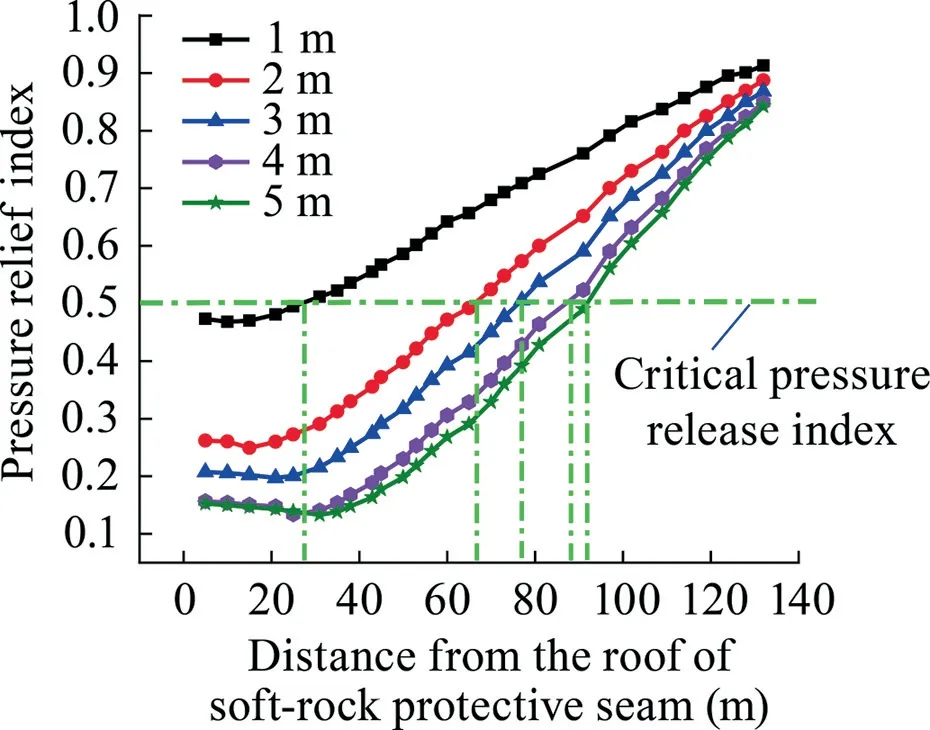
Fig.6.Change in pressure-relief index of mining stress with different mining thickness.
Fig.7 provides the relationship between the mining thickness of the soft-rock protective seam and the critical pressure-relief height of the overlying strata under the simulated geo-conditions.When the mining thickness of the soft-rock protective seam exceeded 4 m,the critical pressure-relief height of the overlying strata increased rather slowly,indicating that the sensitivity of the pressure release effects to the mining thickness gradually decreases.Based on the simulation results,when the interlayer spacing between the soft-rock protective seam and the protected coal seam was 59 m,the minimum mining thickness to achieve a practical pressure-relief effect was 1.85 m.The pressure-relief effect of the protected seam increased with the increasing mining thickness.Considering the overall mining technology requirements of the Luling Coal Mine,the optimized mining thickness of the soft-rock working face was determined to be 2 m.
3.3.Optimization of the working face length

Fig.7.Relationship between the critical pressure-relief height and mining thickness.
Eight schemes were used to optimize the working face length.The mining thickness of the soft-rock working face was fixed at 2 m,and the face length was set to 50,75,100,120,150,180,240,and 300 m.The size of the 3D numerical model was 508 m × 650 m × 284.6 m,and the excavation length was 1.5 times the working face length.At the end of the working face excavation,the vertical stress distribution curve of the overlying strata in the center goaf was drawn along the strike direction with the interlayer spacing of 60 m,as shown in Fig.8.The range of the pressure-relief groove in the goaf expanded gradually with the increasing working face length.
Fig.9 presents the curve for the case of 60 m interlayer spacing,illustrating how the mining stress pressure-relief index varies with the working face length.With the increasing working face length in soft-rock protective seam,the mining stress pressure-relief index demonstrated two stages(Stages Ⅰand Ⅱ)under the simulated geological conditions.In Stage I,the mining stress pressure-relief index in the overlying strata decreased with the increase of the working face length within a particular range.In Stage Ⅱ,when the working face length exceeded the specific value,the overlying strata in the goaf began to be re-compacted gradually in the middle after being broken,and the stress gradually recovered,the mining stress pressure-relief index instead increased with the increase of working face length.Based on the simulation results,by considering a 2 m mining thickness and 60 m interlayer spacing in the protected coal seam,a suitable pressure-relief effect can be achieved for working face lengths in the range of 87–240 m.Specifically,the mining stress pressure-relief index was small when the length was 120–180 m,indicating that this was the optimal range for the working face length.The increased working face length resulted in significant requirements for the reliability of the mechanical equipment on the working face.The length of the soft-rock working face can be determined through the comprehensive assessment of mechanical equipment,mining technology,work efficiency,and cost factors,by taking into account the practical mining experiences pertaining to rock working faces.Based on this,the length of the first soft-rock mining working face (III11) was optimized to 105 m in the III1 mining area,and the length of III13,the second working face,was 125 m.

Fig.8.Distribution of vertical stress on overlying strata along the strike direction with a 60 m interlayer spacing.
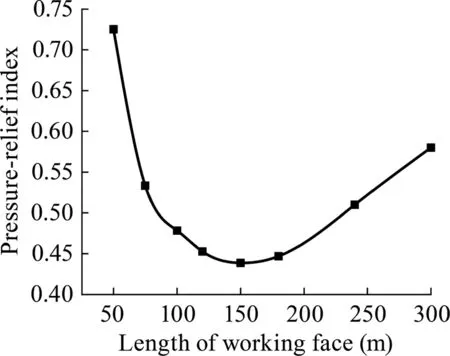
Fig.9.Relationship between the pressure-relief index of mining stress and working face length.
Based on the abovementioned considerations,in the absence of technological conditions conducive to conventional protective seam mining in the III1 mining area,a soft-rock seam containing Kaolin(i.e.mudstone)was selected as the protective seam for mining.On average,the mudstone layer was 59 m away from the floor of seam 9 and 23 m away from the roof of seam 10.The corresponding mining pattern of the soft-rock protective seam was developed (see Fig.10).After the design optimization,the mining thickness and length of the first mining working face in the softrock protective seam were determined to be 2 and 105 m,respectively.
4.Fully mechanized mining technology for the soft-rock protective seam
In China,fully mechanized mining technology has been realized for working face mining in coal mines.The technology is different from that of the protective seam mining of traditional coal seams because the mining orebody belongs to the mudstone for the working face of the soft-rock protective seam.Hence,an independent and fully mechanized production technology may lead to the poor adaptation of fully mechanized equipment and low recovery coefficient of the working face.These cases require further studies on the technology for the fully mechanized mining of the soft-rock layer.
4.1.Physiochemical characteristics of the mining orebody

Fig.11.XRD pattern and SEM image of mudstone.
The physiochemical characteristics of the mining orebody are essential to analyzing and selecting the mining technology.Large mudstone pieces were collected from the III11 soft-rock working face.A representative sample of the mudstone was selected in consideration of the complicated compositions of the rock samples.An X-ray diffractometer (XRD-6000) and scanning electron microscope (SEM,Hitachi S-4800) were then used to analyze the microstructure and morphology of the rock samples,as shown in Fig.11.The XRD results in Fig.11a show that Kaolin clay was the primary component of the mined bed in the soft-rock protective seam mining.From the SEM image in Fig.11b,a block-like structure with conchoidal fracture can be observed.The developed pores and cracks were beneficial for cutting the sample.
A mudstone disintegration experiment was also conducted,as shown in Fig.12.The disintegration of the mined orebody was classified as type Ⅱfor the mudstone.The disintegrated products presented morphologies of particulate,flaky fragments,or pieces,and changed into muddy shapes after firm rubbing.Due to the mechanical effects of the formation water and production water in the mining process,mud formed easily,which made gangue transportation inconvenient.
Large underground mudstone pieces were drilled,cut,ground,dried,and prepared into three mudstone samples of different dimensions (Φ50 mm × 100 mm,Φ50 mm × 50 mm,and Φ50 mm × 25 mm).Physical and mechanical tests were performed using the RMT-150 rock mechanics test system,which was provided by the Mining Engineering Laboratory of Anhui University of Science and Technology.Table 3 lists the physical and mechanical parameters for the soft-rock mining seam.
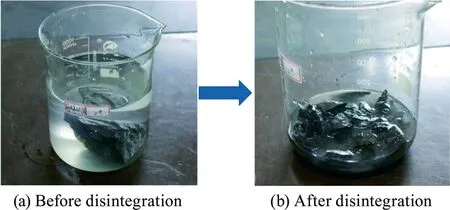
Fig.12.Disintegration experiment photographs of mudstone from mining seam.

Fig.10.Selection diagram of soft-rock protective seam in III1 mining area.

Table 3Measured physical and mechanical parameters of the mined seam (mudstone).
During the advancing period of the two roadways (air roadway and mechanical roadway) of the III11 soft-rock working face,rock samples for mechanical testing were collected above the tunnel cross-section every 50 m.The tested hardness of the rock samples was 1.47–9.30(average=3.52).Among all test parameters,the siltstone and fine sandstone had the highest hardness values,followed by the sandy mudstone,which could hinder the advancement of the working face,thereby resulting in the severe wear of the fully mechanized equipment.Based on the physicochemical characteristics of the mining orebody,the wear resistance of the equipment and mining technological system were critical considerations in the design of the fully mechanized equipment.
4.2.Selection of the fully mechanized equipment
The appropriate selection of equipment and support structures is essential for the safe,high-yield,and high-efficiency production of the soft-rock working faces.The supporting structures and model selection of the fully mechanized equipment were determined by characteristics,productivity,and geological conditions of the mining orebody on the working face.In accordance with the conventional protective seam mining practice,a threemachine assortment was explored for the soft-rock protective seam mining based on the physicochemical properties of the mining orebody.Fig.13 shows the equipment selection framework for the soft-rock protective seam mining.
Mudstone was the main component of the soft-rock working face.Mudstone has a higher capacity (i.e.density,2500 kg/m3) in comparison with coal (1350 kg/m3),resulting in high loads on the cutting and transportation equipment.Therefore,highresistance,high-strength,and high-durability cutting and transportation devices were selected as the supporting equipment.For example,based on the hardness of the mining orebody,an analysis of the rocker and pickle material was involved in the coal cutter selection,and the middle support plate materials were considered in the transportation device selection,thereby enhancing the wear resistance of the fully mechanized mining devices.Further,this process will prolong the service lives of the devices,thereby ensuring continuous operation.
The primary devices of fully mechanized mining faces include the coal cutter,hydraulic support,and transport plane.These devices need to be harmonized in structure and function,demonstrating strong high reliability.They can adapt to the overall requirements of the mining orebody.
(1) Coal cutter selection:The appropriateness of the coal cutter selection directly influences the recovery coefficient of the working face.The average cutting speed and installed power are the main technological parameters influencing the coal cutter performance and are therefore chosen as the basic parameters for the coal cutter selection.Based on calculations,the specified average cutting speed of the coal cutter was 1.67 m/min,the maximum cutting speed was 2.7 m/min,and the installed power was 363.5 kW.A traction coal cutter (MG500/1130-WD AC) was selected.Table 4 lists the specific parameters.A high-strength and no-spark cutting pick and the supporting SGZ-800/800 scraper conveyor were selected.The power of the scraper conveyer was 800 kW,and its transportation capability was 1500 t/h.
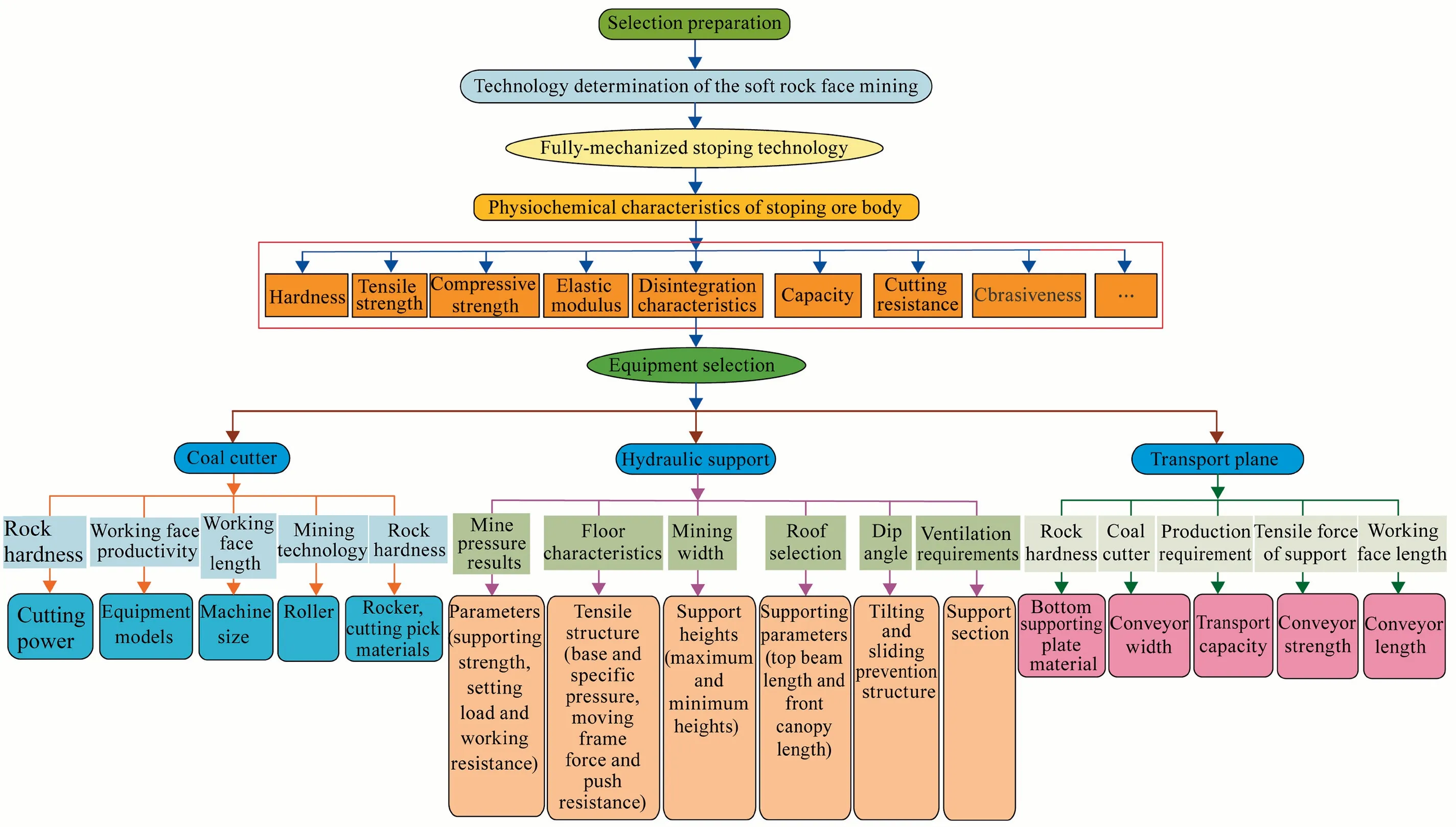
Fig.13.Selection framework of the fully mechanized equipment for soft-rock protective seam.

Table 4Specific parameters of the traction coal cutter (MG500/1130-WD AC).
(2) Hydraulic support selection:The selection of the model of hydraulic support exerts a significant influence on the safety and productivity of the working face.Hydraulic support is required to be stable and reliable,and its working resistance must meet the production needs.The maximum average support strength of the first soft-rock working face of III11 to be mined was calculated to be approximately 650 kN/m2,and the working resistance of the supports was 4641–4894 kN.The hydraulic stability and safety requirements,geological conditions,and production technologies in the III1 mining area were comprehensively considered.A twocolumn shield support (ZY6800/14/28) was selected for mining the first soft-rock working face of III11.The support height,initial supporting force,and working resistance were 1400–2800 mm,4477–5026 kN,and 6800 kN,respectively.The strength of the hydraulic support was 0.89–1.01 MPa,which met the design requirements.
4.3.Production process of the soft-rock working face
Mudstone was mainly mined from the working face of the softrock protective seam.In comparison with mining coal,the hardness or density of the mudstone can be high,which can easily cause high loads on cutting devices,leading to device failure,and this condition may further influence the normal circulation operation of the working face.A production process integrating fully mechanized and blasting-assisted soft-rock mining was developed to ensure the high-efficiency recovery of the soft-rock working face.Specifically,holes were drilled in the rock strata,and vibration shot was placed for the pre-splitting blasting of the rock strata.The coal cutter was then used to mine the soft-rock working face.Based on the specific production demands,a single row of portholes and three portholes were used.In these two arrangements,the porthole depth (waist and bottom portholes) and distance between holes were 1.6 and 1.0 m,respectively.The horizontal and pitching angles were 0°and 10°–15°,respectively.The diameter of the drilling hole was 43 mm,and the explosive payload was 1–2 volumes.The lute length was less than 0.5 m.A millisecond delay electric detonator and a three-level water-gel explosive,which are permissible in coal mines,were used in the series explosion.The explosion order was one charge and one detonation.Fig.14 shows the porthole arrangement of the blasting-assisted coal mining.
5.Engineering application of soft-rock protective seam mining technology
5.1.Optimized arrangement of the first working face in the soft-rock protective seam
The III11 soft-rock working face was the first mining working face in the III1 mining area.The corresponding ground elevation was+23 to+24 m.The strike pressure-relief range of the protected coal seam was studied using FLAC3Dsoftware after the soft-rock protective seam mining [18].Results showed that pressure-relief angles at the cut and terminal lines were 69°and 66°,respectively(average=67.5°).Based on the position and scope of the III1 mining area,the mining length along the strike of the III11 soft-rock working face was 860 m.The elevation of the first mining working face was between-630 and-710 m in the III1 mining area,based on numerous key factors,such as the advancement speed of the working face,gas extraction stages,and pressure-relief protection effect of the protected coal seam.The slope length and mining thickness were 105 and 2.0 m,respectively.Fig.15 presents the specific arrangement.
In addition,the working face of the III11 soft-rock protective seam applied trend long-wall and retreating mining as well as the full-caving method of roof management.The coal cutter was used unidirectionally upward.The cutting occurred in a weak area of the coal wall,and the depth was determined to be 0.5 m to fully realize the cutting efficiency of the coal cutter.The working face pushed the transportation plane forward,bottom-up,or topdown.The hydraulic support was shifted to cave the roof along the direction of advancement.

Fig.14.Porthole arrangement of the blasting-assisted coal mining.

Fig.15.Working face arrangement of soft-rock protective seam in III1 mining area.
5.2.Engineering application effects
5.2.1.Mining effects of the soft-rock protective seam
Since the pilot production of the III11 soft-rock working face,the three-machine supporting facility can completely ensure the normal production of the working face.The working face was mined for 293 d and advanced 492.8 m in total; during the study period,the average daily advance was 1.64 m/d.Fig.16 shows the relationship between mining days and advancement distance during the study period.The advancement distance of the softrock working face was proportional to the mining days,achieving the regular circulation operation of the working faces in the softrock protective seam.
5.2.2.Pressure-relief effect of the protected seam
After mining the soft-rock protective seam,the pressure-relief gas came mostly from overlying seams 8 and 9 (and underlying seam 10).By calculation,the relative gas emission rate was 95.3 m3/t,and the absolute gas emission rate was 110.1 m3/min after the mining of the III11 soft-rock working face.To extract the pressure-relief gas effectively from the protected coal seams and ensure mining safety on the soft-rock working face,a technological system for pressure-relief gas extraction was designed (see Fig.17).Fig.18 shows the relationship between the total net pure flow of the pressure-relief gas extraction and the advancement distance during the soft-rock protective seam mining period.The main roof of the working face fractured during the initial softrock protective seam mining (at advancement distance of 31.3 m),resulting in the first weighting.The permeability of the protected coal seam increased due to the mining,which was accompanied by pressure release and an improved permeability effect.Further,the activation of the adsorbed gas and the flow and desorption of gas could also be observed.The net flow of the pressure-relief gas extraction demonstrated a linear growth trend.When the working face had advanced by 51.8 m,the first periodic weighting developed,and cracks in the overlying strata developed further.The maximum pure flow rate of the pressure-relief gas extraction reached 41.36 m3/min.With the continued advancement of the soft-rock working face,falling gangues in the goaf were gradually compacted,and the pure flow rate of the pressure-relief gas extraction was lessened to some extent.However,high extraction efficiency was still maintained.During the study period,the total pure flow of the pressure-relief gas averaged 29.5 m3/min.

Fig.16.Relationship between mining days and advancement distance during the study period for III11 working face in soft-rock protective seam.
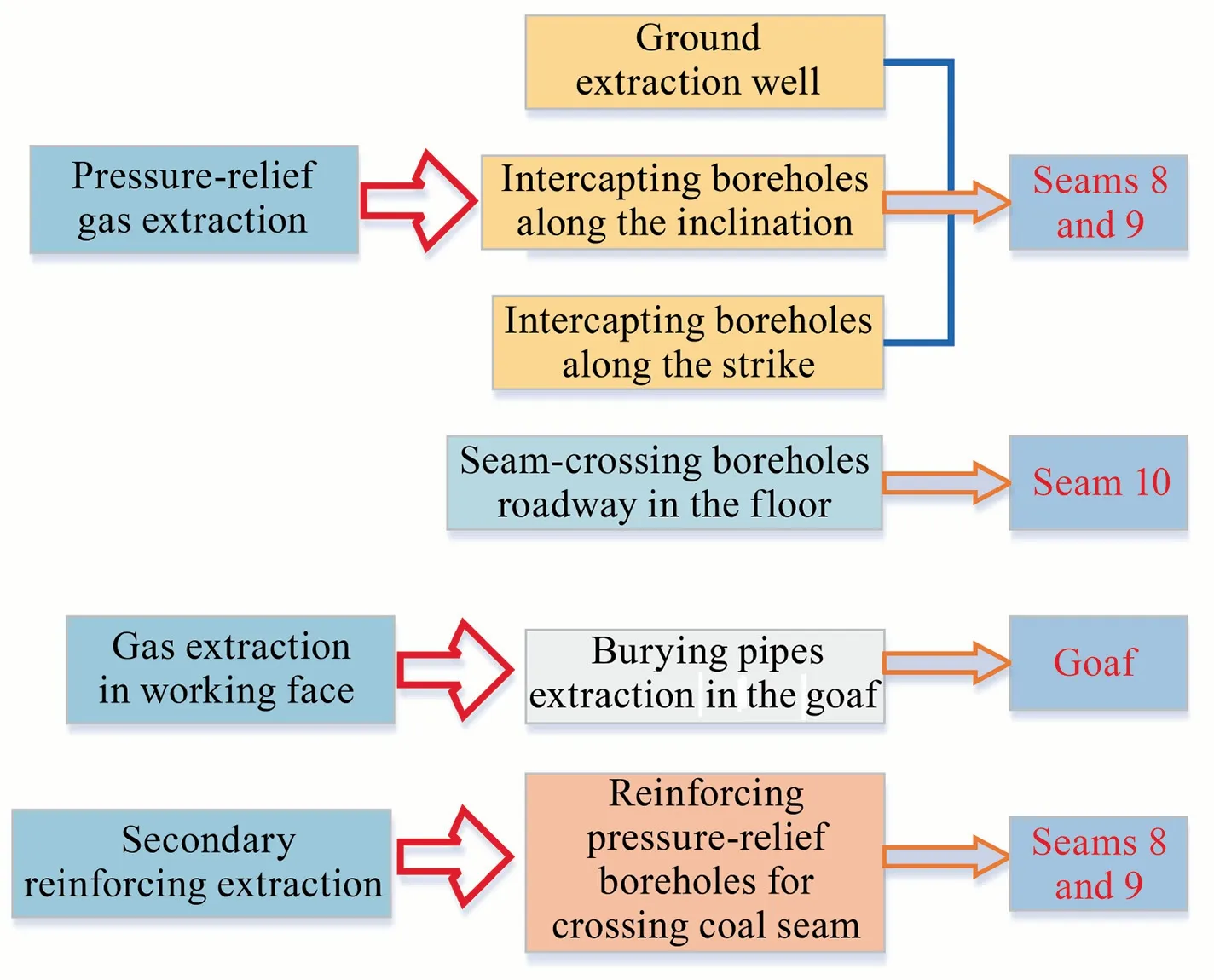
Fig.17.Technological system of pressure-relief gas extraction for soft-rock protective seam mining.
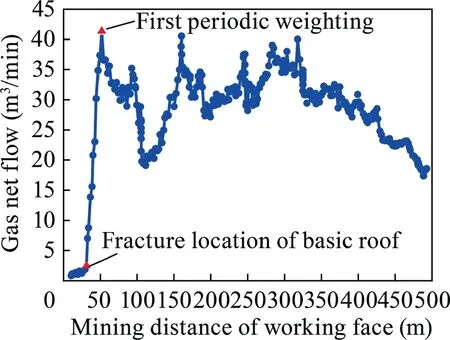
Fig.18.Pressure-relief gas extraction during the investigation period.
Boundary observation boreholes were drilled along the strike at the cut hole by using the special gas extraction roadway (III13).The cut hole position was located in a mining stability zone.Fig.19 shows the test results for the gas pressure and content in the protected coal seams (seams 8 and 9).After the soft-rock protective seam mining,the pressure-relief effect was investigated at the cut position.In the protection range of the protected coal seams (seams 8 and 9),the maximum residual gas pressure and content were 0.35 MPa and 4.87 m3/t,respectively,which were within the critical range.The gas outburst risk in the protected coal seams was eliminated,and an outstanding gas-control effect was realized.
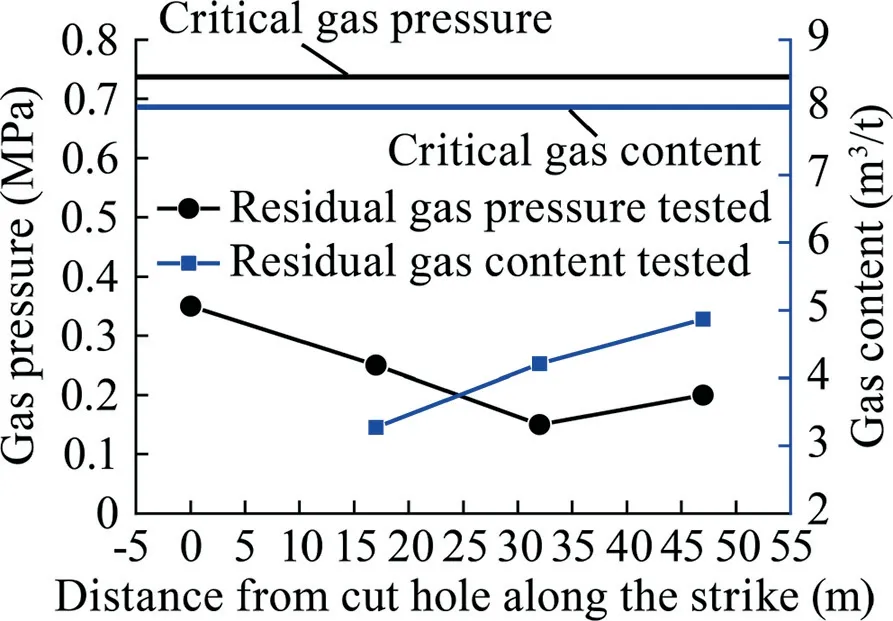
Fig.19.Test results of gas pressure and content curves after soft-rock protective seam mining.
6.Conclusions
(1) The main engineering problems of the first deep mining area of the Luling Coal Mine were analyzed.The traditional mining pattern of protective coal seams faced significant challenges.In the absence of an appropriate and conventional coal seam as the protective seam for mining,an innovative technological concept of soft-rock protective seam mining was proposed for regional gas control.
(2) Design optimization principles for the technological parameters were proposed for soft-rock protective seam mining.The influence rules of the interlayer spacing,mining thickness,and working face length on the pressure-relief effect were analyzed for the protected coal seams.The unit stress of the protected coal seam was less than half of the primary rock stress,which was used as the critical mining stress pressure-relief index.The optimal mining technological parameters,including the 59 m interlayer spacing,2 m mining thickness,and 105 m face length,were determined accordingly.
(3) The physicochemical properties of the mining orebody were analyzed.The device selection framework for the soft-rock protective seam mining was developed,and the key devices of the working face were optimally selected.Further,the production technology,which combined fully mechanized and blasting-assisted soft-rock mining,was determined.Finally,the explosion technique of a single row of portholes and three portholes was selected.
(4) Engineering practices demonstrated that the normal circulation operation could be achieved on the working faces of the soft-rock protective seam,with an average advance of 1.64 m/d.The maximum residual gas pressure and content,which were measured at the cut hole position of the protected coal seams (seams 8 and 9),decreased to 0.35 MPa and 4.87 m3/t,respectively.These findings indicated that an outstanding gas-control effect is achieved by the softrock protective seam mining.
Acknowledgements
This work is financially supported by Anhui University of Science and Technology Introduction of Talents Research Fund Project,Scholastic Key Project (No.QN2019113),Patent Transformation and Cultivation Project (No.ZL201907),Anhui Provincial Natural Science Foundation(Nos.2008085QE222 and 2008085QE260),National Key Research and Development Plan(No.2017YFC0603003),Anhui Provincial Key Research and Development Plan (No.201904a07020010),Anhui Provincial Leading Talent Project of Special Support Plan,National Natural Science Foundation of China (Nos.51974009,51674008,51774012,and 51874002).
杂志排行
矿业科学技术学报的其它文章
- Performance evaluation of near real-time condition monitoring in haul trucks
- Correlating common breakage modes with impact breakage and ball milling of cement clinker and chromite
- Effect of the distributor plugging ways on fluidization quality and particle stratification in air dense medium fluidized bed
- Numerical simulation to determine the gas explosion risk in longwall goaf areas:A case study of Xutuan Colliery
- Experimental study on methane dissolved in surfactant-alkane system
- Effect of slurry conditioning on flocculant-aided filtration of coal tailings studied by low-field nuclear magnetic resonance and X-ray micro-tomography
